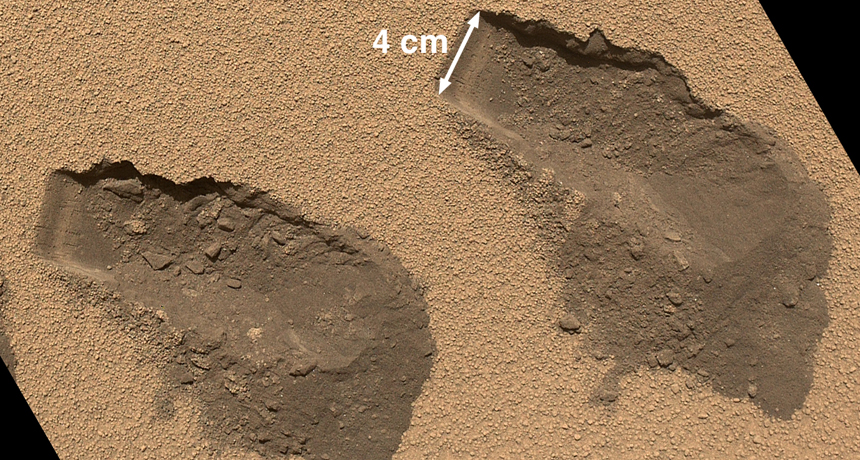Scratching the Martian surface
Latest study of Mars’ soil turns up volcanic rocks, glassy particles and traces of poison

Curiosity, the NASA rover now exploring Mars, scooped up some alien dirt and identified its contents.
JPL-CALTECH/NASA AND MSSS
It’s dirty work, but something has to do it. Curiosity, the NASA rover that’s been rolling around on Mars for more than a year, recently scooped up some alien soil. Like a lab on wheels, Curiosity used its precise onboard instruments to acquire fine details about the soil. Its first analyses are now in. These data offer scientists the best understanding yet of the Red Planet’s past — and present.
There were a few surprises. Among them: a rock that’s unlike any observed on Mars before. Less surprising, but no less interesting: Researchers report finding the alien soil includes traces of a chemical found in rocket fuel. Rover also found volcanic rocks and glassy substances that contain some water. The findings appear in five research papers, all published in the Sept. 27 issue of Science.
“This is the first time we’ve known precisely and definitively what this stuff is made of,” David Blake told Science News. An astrobiologist, Blake worked on the new studies at the NASA Ames Research Center in Moffett Field, Calif. (Astrobiologists study life everywhere — on Earth and in space.)
Blake and his coworkers analyzed data from an onboard instrument called the alpha-particle X-ray spectrometer. This device bombarded the soil with a beam of radiation known as alpha particles. Some of the radiation bounced back into a nearby detector. The spectrometer measured how energetic the alpha particles were. Scientists used those data to determine that the soil held a blend of volcanic rocks and glassy particles.
Another Curiosity instrument beamed X rays at the soil. X rays are a form of radiation that — like visible light — carry energy as a wave. Different minerals bend or reflect X rays in different ways. So scientists can learn about what’s in the soil by studying how X rays bounce off of and around it.
Scientists can also learn about unknown minerals by melting them and then studying what gases they release. Geochemist Laurie Leshin of the Rensselaer Polytechnic Institute in Troy, N.Y., and her coworkers did just this with the Martian soil. They cooked it at about 835 degrees Celsius (1,535 degrees Fahrenheit) and studied the vapors released.
The soil held some water and a chemical called perchlorate. An ingredient in rocket fuel, perchlorate is poisonous to people. Its presence in the soil could pose risks for any research teams that might one day work on Mars.
The water and perchlorate likely came from the planet’s atmosphere, the new reports say. “The dirt is acting as a bit of a sponge,” Leshin explained to Science News.
Curiosity’s instruments also tested a pyramid-shaped black rock. About the size of a football, the rock had been standing alone. The scientists named the rock “Jake_M” in honor of Jacob “Jake” Matijevic, a NASA engineer who died in 2012.
Jake_M resembles a rare type of rock found on Earth’s volcanic islands. “It’s not just that it looks sort of like it,” geologist Edward Stolper told Science News. “You would have a hard time telling them apart.”
Stolper, who works at the California Institute of Technology in Pasadena studied the Martian rock. His team’s analysis of Jake_M may help scientists learn how some rocks formed on Mars. Or, Stolper admits, it may point to a new Martian mystery — especially if it’s the only rock of its kind.
“The question is: ‘Will we find another one?’”
POWER WORDS
alpha particle A type of ionizing radiation, physically equivalent to the nucleus of a helium atom (because it consists of two protons and two neutrons). Alpha particles carry away some of the energy that had been in the nucleus that spewed it. That energy will be deposited into any material with which an alpha particle collides. If it collides with living tissue, this energy release can be very biologically damaging. Alpha particles are emitted by several types of radioactive isotopes, including plutonium, polonium, radium and uranium.
astrobiology The study of life everywhere in the universe, including on Earth and in space.
geochemistryA science that deals with the chemical composition of and chemical changes in the solid material of Earth or of another celestial body (such as the moon or Mars). Scientists who study this are called geochemists.
geology The study of Earth’s physical structure and substance, its history and the processes that act on it. Planetary geology is the science of studying the same things about other planets.
mineral A chemical compound that is solid and stable at room temperatures and has a specific formula, or recipe (with atoms occurring in certain proportions) and a specific crystalline structure (meaning that its atoms are organized in certain regular three-dimensional patterns).
perchlorate This naturally occurring chemical is a potentially cancer-causing component of certain jet fuels, explosives and fertilizers. In animals, this pollutant can perturb levels of thyroid hormones. It also appears capable of acting like an androgen (a male sex hormone).
radiation Energy, emitted by a source, that travels through space in waves or as moving subatomic particles. Examples include visible light, infrared energy and microwaves.
radioactive An adjective that describes unstable elements, such as certain forms of uranium and plutonium. Such elements are said to be unstable because their nucleus sheds energy that is carried away by photons and/or one or more nuclear particles. This emission of energy is known as radioactive decay.
X-rays A form of electromagnetic radiation, similar to visible light, but with a shorter wavelength. Its small wavelength allows it to penetrate and “see through” many solids.







